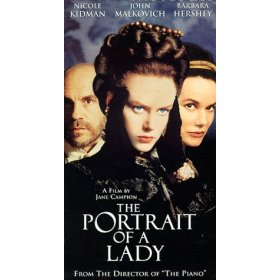

 字體:小 中 大
字體:小 中 大 |
|
|
|
| 2007/02/02 17:43:46瀏覽376|回應0|推薦0 | |
As the best female director working today, Jane Campion’s film version of The Portrait of a Lady has been especially made to accept a challenge to face a female inner dilemma by visualizing her stream of consciousness illuminated as a unique visual manifestation to provide an alternative visual re-reading of James’s original novels. In a moody, highly stylized manner, Campion’s reinterpretation of James’s novel has highlighted her proclivity for female bonds and sexuality that is to be visualized in a different angle from James’s literary version to present the thematic complexities of female psyche. David Kelly, in “The Lady in the Frame: Two Portraits by Henry James and Jane Campion,” considers that Campion’s Portrait is a re-authorising of the original Jamesian narrative, or rather a momentary appropriation of that narrative which is now read as reiterative rather than singular. But then, that narrative had always been reiterative, since James himself had appropriated it from other hands for his own purposes; and he did so precisely because he recognized that to author a text was not simply a self-satisfying expression of one’s aesthetic sensibility—it was to enter the area of textuality with one’s own inclinations, inevitably with a view towards tilting, in one way or another. In portraying Isabel, Campion returns to the realm of female psyche revealed by Isabel who is not only a woman who has her own sexual fantasy but also a woman tinged with a modernist thought that goes beyond her time. Thus, Campion’s films have been enthusiastically taken up by feminist film critics for their depiction of strong female characters rebelling against the roles expected of them by patriarchal society. In highlighting her affinity to James’s Isabel, Campion understands that she has to add to her own authorial voice into the film. The fundamental difference, however, is that James’s Isabel chooses to be united with the decadent monster Osmond and then is obliged to live with the consequences of her choice, yet Campion’s Isabel is not. Campion utilizes disturbing cinematic scenes, namely “prologue,” “sexual fantasy on the bed,” and “surreal black-and-white documentary”, to dramatize Isabel’s sexuality. In the film, the opening “prologue” visualizes contemporary teenage Australian girls who discuss the excitement of their first kiss and romantic love in a frank tone that is contrasted with Isabel’s repressed desire. Campion then visualizes Isabel’s sexual desires in a fantasy sequence when she imagines her three suitors kissing her, touching her body, and observing her on the bed. Most important, the director uses a documentary film to manifest Isabel’s surreal traveling dream to Whereas James’s Portrait is to glimpse Isabel through Ralph’s consciousness to stage the liberation that comes from a man’s desires, Campion’s Portrait reveals the dangers of female desire, the seduction that leads to entrapment in a loveless marriage. In this sense, Campion’s Isabel returns to a pre-Oedipal stage by following her own fetishistic desire of being with her mother’s portrait instead of father’s. By doing so, Campion successfully and vividly detail Isabel’s female psyche in a more contemporary and feminist tone than the one presented in James’s literary version. |
|
| ( 創作|文學賞析 ) |










